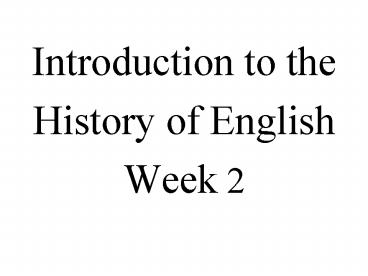Introduction to the - PowerPoint PPT Presentation
1 / 29
Title:
Introduction to the
Description:
almost imperceptible (unless on a ... Celtic Britain. Roman Britain: ... (Old Irish p-loss is Common Celtic) PIE Reconstruction 2. Greek pater. Sanskrit pitar ... – PowerPoint PPT presentation
Number of Views:20
Avg rating:3.0/5.0
Title: Introduction to the
1
- Introduction to the
- History of English
- Week 2
2
- Language change is...
- gradual
- almost imperceptible (unless on a larger temporal
scale) - usually the result of two (or more) rivalling
forms coexisting for some time, then one giving
way to the other - the phenomenon that creates a historical
continuum - a universal fact
3
- Language change operates on all levels
- phonetic change (e.g. apocope, syncope)
- phonemic change (e.g. Grimms Law)
- morphological change (e.g. loss of inflections)
- syntactic change (e.g. word order)
- lexical change (e.g. loan words, use of words)
- semantic change (e.g. extension of meaning)
- pragmatic change (e.g. address terms)
4
- Periodization
- OLD ENGLISH (OE) ca. 450-1100
- MIDDLE ENGLISH (ME) ca. 1100-1500
- MODERN ENGLISH (MdE) ca 1500-
- Early Modern English (EMdE) ca. 1500-1650
- Late Modern English (LMdE) ca. 1650-1800
- Present Day English (PDE) ca. 1800-
5
- historical variation (diachronic) vs.
- geographical/social variation (synchronic)
- geographical variation in Old English
- Northumbria
- Mercia (incl. East Anglia)
- Wessex
- Kent
6
- geographical variation in Middle English
- North
- West Midlands
- East Midlands
- South
- Kent
- geographical variation in Modern English...
7
- external history
- Celtic Britain
- Roman Britain
- Celts Romans (55BC) Scots/Picts (ca.350AD) -
Anglo-Saxons (449AD) - 3. Anglo-Saxon England
8
(No Transcript)
9
Evidence in historical linguistics
- Data available for living languages?
- Introspection (linguist native speaker)
- Elicitation (informants native speakers)
- Observation ( use of corpora)
- Data available for historical linguistics?
- More restricted ? no introspection, no
elicitation - Corpus of written texts as a record of actual
language use
10
Historical data - corpora
- The further back we go in time, the more sparse
and unreliable the data become (Schendl 2001
11) - ? cf. Helsinki Corpus (1992) most important
corpus for studies of OE, ME EModE - OE Old English (c 500 1100)
- ME Middle English (c 1100- 1500)
- EModE Early Modern English (c 1500 1700)
11
Other historical corpora
- Penn-Helsinki Corpora of Middle Early Modern
English - Toronto Corpus (OE)
- Middle English Medical Texts (MEMT)
- Corpus of Early English Dialogue (CED)
- Corpus of Early English Correpondence (CEECS)
12
Written evidence
- Data exclusively written in nature
- ? no spoken evidence before 20th c.
- Written evidence in English since ca. 700 A.D.
- (AD Anno Domini vs. BC Before Christ)
- ? No writing gt Reconstruction
13
Reliability of written evidence
- How phonetic is phonetic spelling?
- Use a spelling system developed for another
language - Conservative spelling mixing of different
spelling conventions due to cultural contact - Handwriting errors
- Translations
14
Reconstruction
- Ideas behind reconstruction
- a proto-language
- common source from which languages may originate
- language family
- genetically related languages ? show systematic
and recurrent formal correspondences
15
- IE family tree
16
Reconstruction 2
- mother, daughter and sister languages
- How can we represent relations?
- ? family tree model
- Why diverge?
- geographical distance and isolation (internal)
- social factors and political developments
- contact with other languages
17
Reconstruction 3
- Reconstruction how?
- cognates
- words which are similar in form and meaning and
which go back to a common source - ? similarities not because of borrowing or
coincidence but because of genetic relatedness!!! - frequent in basic vocabulary (e.g. concepts
such as kinship, body parts, or the basic
numerals)
18
Example
19
- IE family tree
20
Methodological principles
- Two Principles
- Phonetic Plausibility
- Majority Principle
21
Grimms Law
- voiced aspirated stops gt voiced stops
- /bh, dh, gh/ gt /b, d, g/
- voiced stops gt voiceless stops
- /b, d, g/ gt /k, t, p/
- voiceless stops gt voiceless fricatives
- /k, t, p/ gt / f, ?, x/
- ? an unconditioned sound change affecting all the
stop consonants of Germanic - ? a chain reaction (a push or a drag chain)
22
Verners Law
- According to Grimms Law
- where Latin has /t/ ? a Germanic language should
have /?/ - BUT pater father, mater mother ? /ð/
- Verners Law
- a subsequent change to the voiced fricative
when - it did not occur in word-initial position
- it occurred between voiced sounds
- the preceding syllable had been unstressed
- e.g. father the consonant word-medial,
between two voiced vowel sounds and the first
syllable of the word was historically unstressed
23
PIE Reconstruction 1
- Greek pater
- Sanskrit pitar
- Latin pater IE
- Gothic fadar
- Old Irish athir
- (Old Irish p-loss is Common Celtic)
24
PIE Reconstruction 2
- Greek pater
- Sanskrit pitar
- Latin pater IE p
- Gothic fadar
- Old Irish athir
25
PIE Reconstruction 3
- Greek pater
- Sanskrit pitar
- Latin pater IE p t
- Gothic fadar
- Old Irish athir
26
PIE Reconstruction 4
- Greek pater
- Sanskrit pitar
- Latin pater IE p t r
- Gothic fadar
- Old Irish athir
27
PIE Reconstruction 5
- Greek pater
- Sanskrit pitar
- Latin pater IE p ? t e r
- Gothic fadar
- Old Irish athir
28
PIE Reconstruction 6
- Greek pater Indo-European
- Sanskrit pitar
- Latin pater IE p ? t e r
- Gothic fadar
- Old Irish athir
29
PIE Reconstruction 7
- Greek pater Indo-European
- Sanskrit pitar
- Latin pater IE p ? t e r
- Gothic fadar
- Old Irish athir proto-language































